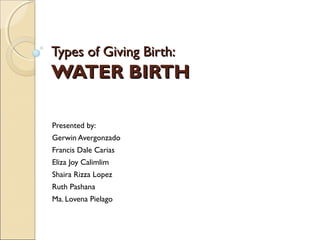
water birth
- 1. Types of Giving Birth: WATER BIRTH Presented by: Gerwin Avergonzado Francis Dale Carias Eliza Joy Calimlim Shaira Rizza Lopez Ruth Pashana Ma. Lovena Pielago
- 2. What is Water Birth?
- 3. It is the process of giving birth in a tub or pool of warm water. It is also considered as the gentlest birth. Considered as an alternative way of giving birth.
- 5. The theory behind this type of giving birth is that the baby has been in the amniotic sac for nine months and emerging in a water environment is gentler and less stressful for both the mother and the baby. It is also believed that it reduces stress during labor and birth which also reduces fetal and maternal complications.
- 6. History of Water Birth
- 7. Laboring in water is used by women for millennia. It is supported by Janet Blaskas. She is a writer about water births and describes the oral histories of South Pacific Islanders giving birth in shallow sea water. It is also considered as a recent development in the Western world. The first water birth that we know about in Europe was in 1803 in France. During the 1960s, Igos Charkovsky undertook considerable research into the safety and possible benefits of water birth in Soviet Union.
- 8. In the late 1960s, Frederick Leboyer, French Obstetrician developed the practice of immersing newly-born infants in warm water to help ease transition from the womb to the outside world, and to mitigate the of any birth trauma. Michel Odent, another French obstetrician, began using the warm-water birth pool for pain relief for the mothers. During these trials, some women refused to get out of water to finish birthing. It lead Odent to research about the benefits for the babies and the possible problems in such births. By the late 1990s, interest in water birth grew in UK, Europe and Canada.
- 9. Benefits Of Water Birth
- 10. For the Mother: Water is soothing, calming and relaxing. Water seems to increase woman’s energy. Buoyancy lessens body weight which allows free movement and new positioning. Buoyancy promotes more efficient uterine contractions and better blood circulation, resulting in better oxygenation of the uterine muscles, less pain for the mother, and more oxygen for the baby. Immersion in water often helps lower high blood pressure caused by anxiety. Water seems to alleviate stress-related hormones, allowing the mother’s body to produce endorphins, which are pain-inhibitors.
- 11. Water causes the perineum to become more elastic and relaxed, which reduces the incidence and severity of tearing and the need for an episiotomy and stitches. As the laboring woman relaxes physically she is able to relax mentally, concentrating her efforts inward on the birth process. The water provides a sense of privacy, which releases inhibitions, anxiety, and fears. For the Baby: Provides a similar environment as the amniotic sac. Eases the stress of the birth, providing reassurance and security. It is also believed that water babies are cries less and are calmer and more alert.
- 12. Risks Of Water Birth
- 13. Theoretical risk of water embolism, which is when the water enters the mother’s blood stream. Water Aspiration – inhaling water but babies doesn’t actually inhale “air” until they’re exposed to it. Infections – if the water is not clean.
- 14. Who should not have Water Birth?
- 15. If you are having multiple births. If you have herpes If your baby is breech (suhi) Preterm labor is expected Severe *meconium or bleeding If you have *toxemia or preeclampsia *meconium-earliest stools of an infant *toxemia-pregnancy induced high blood pressure
- 16. Videos of Water Birth
- 19. Movie Clip of “The Back-up Plan”
